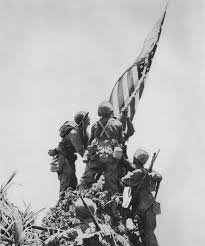On April 1, 1945, American troops under the command of Lieutenant General Simon B. Buckner Jr. landed on the southwest coast of Okinawa, Japan. Their objective was to capture Okinawa as a base for the army ground and air forces for a later assault on mainland Japan. However, the Japanese had other plans.
Buckner was a highly educated military leader who graduated from West Point in the class of 1908. His father, Simon Bolivar Buckner Sr., was an American soldier, Confederate General, and politician. Buckner Jr., had a distinguished military career, spending most of his first 17 years in military schools, war colleges, or courses of similar design. He spent the remainder of his career in direct command and service with troops, but his military career would come to an end during the battle for Okinawa. Buckner was killed by enemy artillery fire just three days before the Japanese surrender, becoming the highest-ranking American officer to be killed by enemy fire during the war.
The Battle of Okinawa, also known as Operation Iceberg, was the largest amphibious assault in the Pacific War and the last major battle of the war. The battle began 78 years ago today, on April 1, 1945, and lasted for nearly three months, until June 22, 1945. The objective of the battle was to capture the Japanese island of Okinawa, which was strategically located between Japan and Taiwan. Okinawa would serve as a base for the upcoming invasion of mainland Japan.
The American forces were led by Lieutenant General Simon B. Buckner Jr., who was the commander of the U.S. Tenth Army. The Tenth Army consisted of the XXIV Corps and the III Amphibious Corps. The XXIV Corps was led by Major General John R. Hodge and consisted of the 7th, 27th, 77th, and 96th Infantry Divisions. The III Amphibious Corps was led by Major General Roy Geiger and consisted of the 1st, 2nd, and 6th Marine Divisions.
The American forces faced significant resistance from the Japanese defenders, who were commanded by Lieutenant General Mitsuru Ushijima and Lieutenant General Isamu Chō. The Japanese defenders were well-prepared and heavily fortified, with underground tunnels, bunkers, and caves. The Japanese also had a large number of artillery pieces, mortars, and machine guns, which they used to devastating effect.
The Americans landed on the beaches of Okinawa without loss of men, but they quickly faced fierce resistance from the Japanese defenders. The Americans had to advance inland, where they faced a series of deadly battles. The Japanese defenders used guerrilla tactics, such as ambushes and surprise attacks, to inflict heavy losses on the American forces. The Americans had to clear each cave and bunker one by one, which was a slow and dangerous process.
The battle for Okinawa was also notable for the extensive use of kamikaze attacks by the Japanese. The kamikaze attacks were suicide missions, in which Japanese pilots would deliberately crash their planes into American ships. The kamikaze attacks were highly effective and caused significant damage to the American fleet. In total, the kamikaze attacks sank or damaged over 300 American ships, including 30 warships.
The battle for Okinawa was one of the bloodiest battles of the Pacific War. The Americans suffered over 50,000 casualties, including over 12,000 killed in action. The Japanese defenders suffered even more, with over
In the aftermath of the battle, the American forces established a military government on Okinawa and began to rebuild the island. The Battle of Okinawa also had significant cultural and political implications. Okinawa had been an independent kingdom until it was annexed by Japan in 1879, and the battle brought the island into the global spotlight.
The battle and its aftermath also had a significant impact on the decision to use atomic bombs on Japan. The high casualties and fierce resistance encountered during the battle led American leaders to believe that a ground invasion of mainland Japan would result in even higher casualties. This belief, along with other factors, led to the decision to drop atomic bombs on Hiroshima and Nagasaki, ultimately leading to Japan's surrender and the end of World War II.
The Battle of Okinawa was a pivotal event in World War II and the Pacific War. The battle was the largest amphibious assault of the Pacific War and the last major battle before the end of the war. The battle was costly, with significant casualties on both sides, but it provided the Allies with a base of operations for the upcoming invasion of mainland Japan.
The battle had cultural and political significance, bringing Okinawa into global focus and leading to the use of the atomic bomb. It's a reminder of the bravery and sacrifice of WWII veterans whose impact on the world still shapes modern policies.




Comments